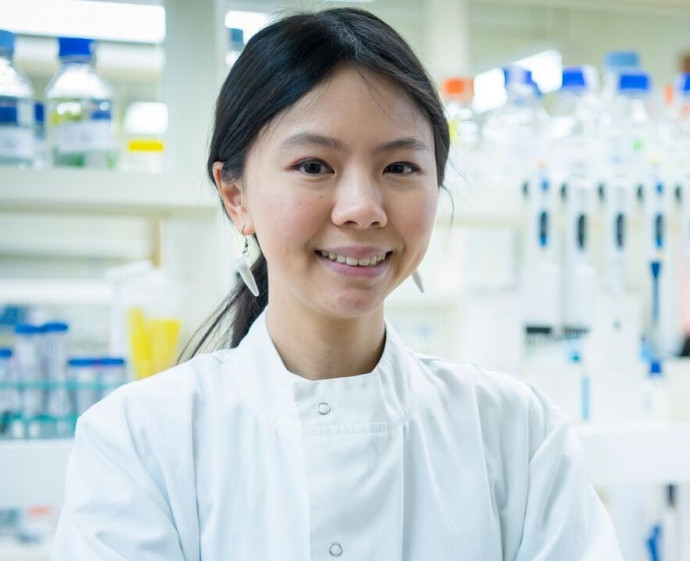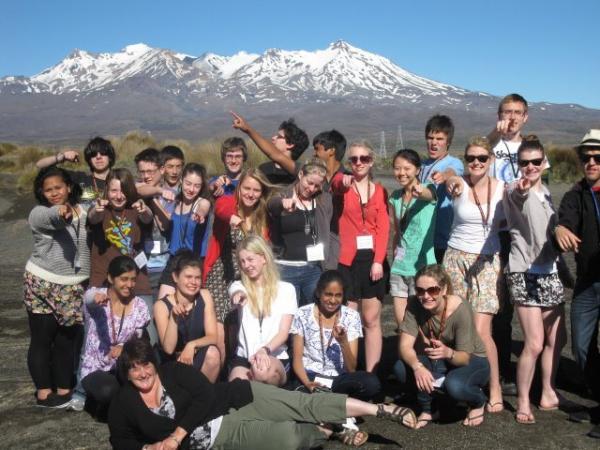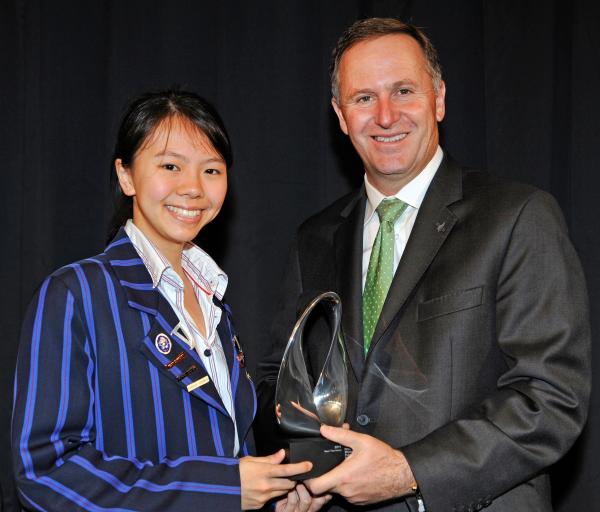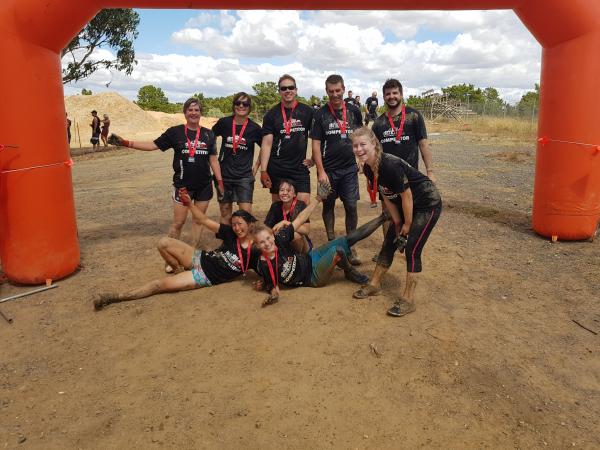Nuan-Ting Huang

Nuan-Ting Huang began her journey with Royal Society Te Apārangi when the Prime Minister's Secretariat selected her for the Prime Minister's Future Scientist Prize in 2011. She has covered a lot of ground since then and is now working at CSIRO.
Growing up, I thirsted for knowledge. The world is full of mysteries I wanted to better understand and I believe it is that thirst which has led me to choose a career in science. I would like to briefly share with you my journey: the decisions I have made to be where I am now and the lessons learnt from them.
Throughout school I had multiple dream jobs; I wanted to be a vet, pilot, actress, firefighter, animator… the list goes on! But then came Year 10 and I decided that it would be pretty cool to be a pathologist. I researched online to see what subjects were needed to set myself up for that career path and picked all three sciences for the International Baccalaureate (IB) Diploma Programme. One of the key assessments for the IB was the extended essay (EE), a self-directed research project that required students to write a 4,000-word dissertation in the end. It was a no-brainer for me to pick Biology as my subject. However, I was having trouble designing an experiment that would realistically encompass my interest in human biology.
Fortunately, my school (Diocesan School for Girls) had recently had their annual Women2Watch assembly and I reached out to one of the recipients of the award, Dr Julie Lim, for advice. She connected me to her supervisor, Prof. Paul Donaldson, who then set me up to meet with Dr John Phillips. Dr Phillips introduced me to the world of myopia research, taught me how to search for relevant research articles online, helped me brainstorm experiments and gave me resources to conduct them. After many discussions, I opted to look at the effects of cognitive and non-cognitive tasks on eye pupil size, and to see if the results correlated with visual acuity changes. In the end, I got results I wasn’t expecting but that only invigorated me to analyse those results and figure out why and how they came about.
Lesson one: Be proactive and reach out. Doors won’t open for you unless you knock. But once you get through that first door, many more will come your way.

Realise the Dream 2011 cohort – I am the one in the green shirt!
Following the submission of my EE, I was encouraged by my supervisor, Mrs Sarah Boasman, to enter it as a poster in the NIWA Auckland Regional Science Fair. At the time, I was not expecting much from my entry but when I found out I had placed and consequently been nominated into the Royal Society Te Apārangi’s Realise the Dream event, I was catapulted into a world of like-minded individuals. For one week we were exposed to the real-life applications of science in our community, as well as learn about each participant’s research project. It was humbling and inspirational to be a part of the 2011 cohort – everyone was curious, hard-working and passionate about making positive impacts in the world. To this day, I am still unable to describe how I felt when I was awarded the Supreme Award and subsequently the Prime Minister’s Future Scientist Prize. I am forever grateful for the opportunities those awards have given me in my journey.
Lesson two: You won’t know unless you try. You are only letting yourself down if you choose to not give things a go.

Receiving the Prime Minister's Future Scientist Prize in 2011
Receiving the Supreme Award gave me the privilege to travel to Slovakia for the European Union Contest for Young Scientists at the end of my first year as a biomedical science major at the University of Auckland. Again, it was another humbling experience to meet aspiring scientists from across the globe. Coming back from the contest, I made new friends and a renewed drive to chase a career in research.
However, as I progressed through my degree, it became increasingly obvious that my grades were not going to quite make the cut for me to be in a strong position to apply for an Honours project and ultimately, a PhD scholarship. Luckily, I kept in touch with Dr Lim and Dr Phillips and asked for their opinion on how I should move forward. Their suggestion to start anew with a postgraduate degree led me to pursue a Master of Neuroscience (Advanced) at The Australian National University.
Lesson three: Persevere, persevere and persevere. Don’t be a stranger to 'failure'. They’re opportunities for you to learn and better yourself, and don’t be afraid to ask for help when you need it. After all, collaboration is a key part of science.
My Masters research project, ‘Developing an ex vivo photo-oxidative model for retinal degeneration,' focused on producing a suitable retinal explant model for retinal degeneration. I was supervised by Assoc. Prof. Krisztina Valter of the Valter group at The John Curtin School of Medical Research. The project provided ample opportunities for me to work with cell culture, organ culture, cryosectioning and immunohistochemistry – I was having the time of my life! However, it was a challenging project and despite me getting a High Distinction for the thesis, I was already re-assessing where I wanted to go from there. I wanted to be involved with research but I was burnt out from having gone from high school, straight to undergrad then postgrad. So, I decided to take a bit of a breather, pick-up a few more molecular techniques and have a slight change of scenery…
I am now a research technician with the rabbit lagoviruses group, a team within the Managing Invasive Species and Diseases division of the Commonwealth Scientific and Industrial Research Organisation. My main job is to conduct molecular diagnostics on rabbit samples we receive from submitters nationwide; if the samples are positive for rabbit haemorrhagic disease virus, I can discern what strain it is. These will later be sequenced for us to study the molecular epidemiology and evolution of current circulating rabbit lagoviruses in Australia. I also have the privilege to participate in field work, assist with the publication of research papers, liaise with interstate and international collaborators, and help with animal trials – all of this so that we can better assess strategies to minimise the impacts of invasive rabbits on Australia’s flora and fauna.
I find my work very rewarding as it aligns with my wish to use science as a means to give back to my community and environment. I am also very fortunate to have supervisors that are genuinely interested in my professional growth by encouraging me to attend workshops, present at our weekly journal club and giving me the opportunity to be the laboratory custodian for our group.
Lesson four: Find people that are invested in your development. Projects come and go, but the people you work with can have lasting impacts on your future.

I am very lucky to be able to work with a group of people that likes to do ‘team-building’ activities outside of work! This is only a few people from my lab group, plus friends, after we completed the Obstacle Hell course in Canberra.
Despite all of my responsibilities at work, we also foster a culture that embodies good health and safety practices. I cannot stress the importance of having work-life balance; not only is it good for you physically and mentally, it will help increase productivity and reduce your risk of burn-out. A lot of people assume that I don’t have free time because I’m working in research and that is a stereotype I want to challenge. In my current job, I am able to spend time with my family and friends and enjoy the things I like outside of science, which includes investing in my dream hobby of cosplaying!
Moving forward, I would like to do a PhD but that isn’t an aspiration until maybe a few years later. It isn’t a race for me to get one, and I am perfectly content with where I am right now in helping tackle Australia’s rabbit problem!
Fifth and final lesson: Pursue balance and recognise that it is completely acceptable to take a break if you need it. No job is worth prioritising your health over.

Me cosplaying as Megumin from ‘Konosuba: God’s Blessing on this Wonderful World!’- I make all of my costumes and it is an amazing creative outlet for me – highly recommend this hobby to anyone interested! Photographer: MLPS Photography
I hope you found my story helpful! My email (Nina.Huang@csiro.au) is open to anyone who would like to get in contact about anything I have mentioned here, or in relation to their own science journey.
